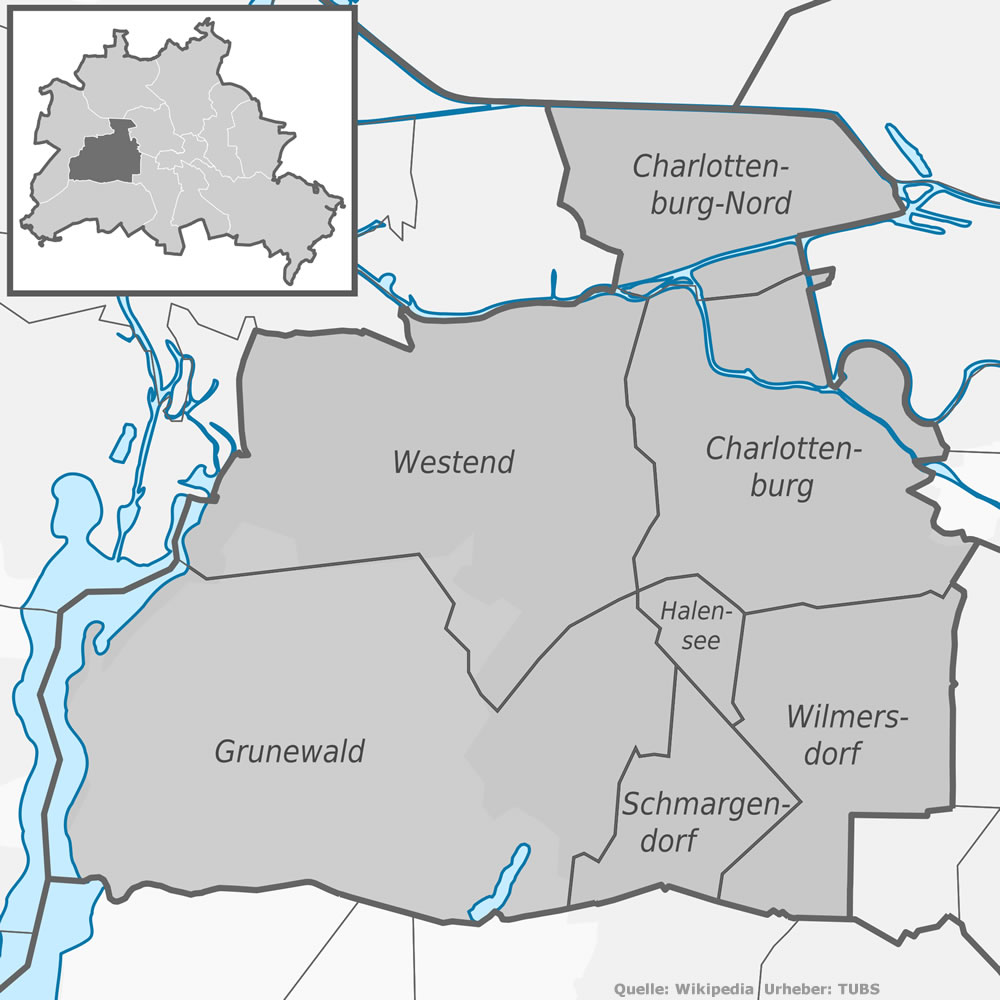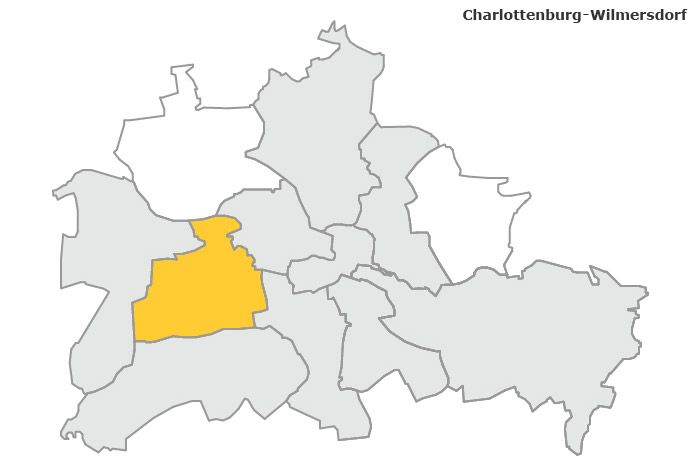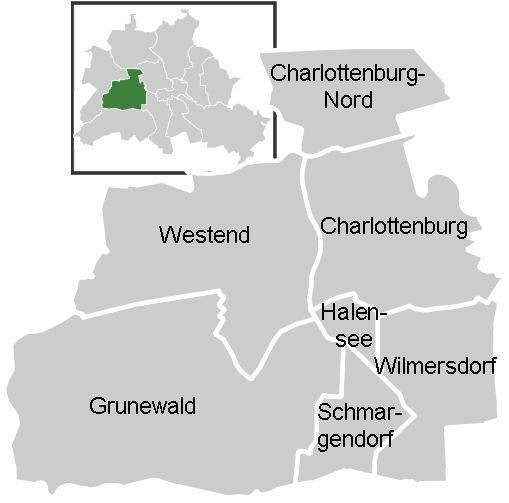Charlottenburg-Wilmersdorf
7 districts
Charlottenburg- Wilmersdorf is the fourth borough of Berlin and has approximately 300,000 inhabitants. The district is now regarded as more middle-class residential district. The area around the Kurfürstendamm takes as " City West " next to the historical center center functions for the whole of Berlin true. Other points in the district institutions include the Technical University of Berlin, the University of the Arts Berlin, the German Opera Berlin, the Federal Office for Building and Regional Planning, the Federal Institute for Risk Assessment and the Berlin Olympic Stadium.
- 6.1 International
- 6.2 National
Districts
The district is divided into seven districts:
- Joke life
- Klausenerplatz
- Kalowswerder
- Rheingauviertel
- Villenkolonie Westend
- Neu-Westend
- Pichelsberg
- Ruhleben
- Settlement Eichkamp
- Municipal highway
- Jungfernheide
- Paul Hertz settlement
- Berlin- Plotzensee
- Großsiedlung Siemens City
The district is inhabited very different. In addition to the densely populated districts of Wilmersdorf ( Rank 7 in Berlin), Charlottenburg and Hallensee ( rank 11 and 12) Grunewald, one of the most sparsely populated districts of Berlin. In the district of Grunewald three percent of the population of the district live on more than one third of the total area of the district, however, accounts for about 85 percent of the area of the district on the ( uninhabited ) Grunewald forest and water areas. Two thirds of the population of the district lives in Charlottenburg and Wilmersdorf. Hallensee is after the Hansa quarter of the second smallest district of Berlin, while the district of Grunewald one of the largest.
Population
Charlottenburg- Wilmersdorf is regarded as rather bourgeois district. 31 October 2013, the district of Charlottenburg- Wilmersdorf counted 302 040 inhabitants in an area of 64.7 square kilometers. Thus, the population density was 4,667 at the date inhabitants per square kilometer. On 31 December 2012, the proportion of foreigners was 20.2 percent, while the share of the population with a migration background was at 36.0 percent. The unemployment rate amounted on 30 April 2013, 10.7 percent. On 31 December 2012, the average age of the population was 45.7 years.
History
The district was created on 1 January 2001 by the merger of the former districts of Charlottenburg and Wilmersdorf (both formerly West Berlin).
On 25 May 2009 the District received the loaned by the federal government title place of diversity.
Charlottenburg
Emerging from the community Lietzenburg (originally Lietzow ) on whose territory in honor of Queen Sophie Charlotte Schloss Charlottenburg built and 1705, the city was founded in Charlottenburg. Until the incorporation to Greater Berlin in 1920, Charlottenburg developed the richest city in Prussia. ( → ... more to Charlottenburg and its history )
Wilmersdorf
The present district of mid-18th century was founded after 1220. Acquired the first Berlin citizens and country farm houses in the then German -Wilmersdorf and taught summer seats in the Wilhelmsaue one. By April 1, 1907 Wilmersdorf retired from the district Teltow and became an independent city circle. From 1912, the city introduced the name Berlin -Wilmersdorf. On 1 October 1920, the city was incorporated into Greater Berlin. ( → ... more Wilmersdorf and its history )
Attractions
- Grunewaldturm
- Cross Church in Schmargendorf
- Village church in Berlin- Schmargendorf
- Rathaus Schmargendorf
- Artist colony Berlin
- Monument at Schildhornstrasse for Jaxa of Köpenick
- Marko Marulić statue on Julius Morgenroth Square
- Schloss Charlottenburg
- Luis Church of Karl Friedrich Schinkel in the Gierkeplatz
- Rathaus Charlottenburg
- Berlin Radio Tower
- Exhibition Centre and ICC Berlin
- German Opera in Berlin
- Schaubühne place
- Theatre of the West
- Renaissance Theatre
- Schiller Theatre
- Berlin Olympic Stadium and the Olympic site
- Breitscheidplatz Memorial Church, Europa Center and Wasserklops
- Plotzensee Memorial
- Protestant Community center Plotzensee with the Plötzensee Totentanz by Alfred Hrdlicka
- Stoessensee and high banks on Rupenhorn
- Villa Oppenheim
- National Museums in Berlin: Museum of Prehistory and Early History
- Museum Berggruen
- Museum of Photography / Helmut Newton Foundation
- Collection Scharf -Gerstenberg
- Gipsformerei
Coat of arms
The coat of arms of the district of Charlottenburg- Wilmersdorf was awarded on 4 September 2001 by the Senate of Berlin.
"Under silvery - blue split main shield, in three lilies in confused colors, in a Gold gezinntes blue castle gate with open black portcullis, the side towers with domes, the central building with a hipped roof that is sullied up with two averted flags, the right black - silver, the silver left red - divided. The side towers each filled with a shield: right in silver, a gold -winning and reinforced black eagle with golden clover stalks on the wings and chest covered with the golden monogram Fri, surmounted by a golden crown; left Gules, a jumping horse. The escutcheon is placed a red three-towered mural crown, whose central tower is occupied by the Berlin coat of arms. "
The coat of arms was created from the previous own coat of arms of the districts of Charlottenburg and Wilmersdorf. The lower panel of the split plate shows a floating blue gezinntes castle gate has a keyed black portcullis in the passage of the center building. This element of Charlottenburg has some historical details - the front tower symbolizes the Kingdom of Prussia with the laying on plate with Prussian eagle and the black and white flag, while the rear tower of the House of Hanover is, with the prancing horse and the red-white flag. The element of Charlottenburg Palace was enriched by the three blue - silver-colored lilies that were taken from the coat of arms of the district of Wilmersdorf - these elements refer here to the founder of Wilmersdorf from the 1802 extinct dynasty of Wilmersdorf. The mural crown is the unifying element of all districts in Berlin.
Twinning
Internationally
Netherlands Apeldoorn (Netherlands), since January 5, 1968 with Wilmersdorf
Hungary Budapest (fifth district, Hungary), since 9 June 1998, Charlottenburg
Gagny France (France), since 1992 Wilmersdorf
Gladsaxe Denmark (Denmark), since January 5, 1968 with Wilmersdorf
Israel Karmiel (Israel ), since 16 January 1985 Wilmersdorf
Ukraine Kiev ( Ukraine), since 21 February 1991 Wilmersdorf
United Kingdom London Borough of Lewisham (United Kingdom), since 19 March 1968, Charlottenburg
Austria Linz ( Austria ), since 9 June 1998, Charlottenburg
Poland Międzyrzecz (formerly Meseritz, Poland), since 11 June 1993 Wilmersdorf
Israel Or Yehuda (Israel ) since 1966 with Charlottenburg
Croatia Split ( Croatia), since May 5, 1970 with Wilmersdorf
United Kingdom London Borough of Sutton (United Kingdom), since April 18, 1968 with Wilmersdorf
Italy Trento (Italy ), from 11 May 1966, Charlottenburg
National
- Bad Iburg, since 10 November 1980 with Charlottenburg
- Rheingau- Taunus-Kreis, since 20 June 1991 Wilmersdorf - sponsorship since September 5, 1972
- Forchheim district since August 23, 1972 with Wilmersdorf - sponsorship since 1974
- District of Kulmbach, since 23 August 1991 Wilmersdorf
- Marburg- Biedenkopf, since 18 April 1991 with Charlottenburg
- Waldeck- Frankenberg, since 26 November 1988 Charlottenburg
- Mannheim, since May 28, 1962 with Charlottenburg
- Minden, since January 5, 1968 with Wilmersdorf

.svg/2000px-Berlin_Bezirk_Charlottenburg-Wilmersdorf_(labeled).svg.png)








